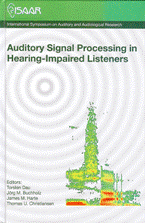Exceeding individual working memory capacity restrains aided speech recognition performance - effects in complex listening situations and effects of acclimatization
Abstract
Two experiments were carried out that investigated individual working memory capacity and speech recognition performance in noise. Experiment 1 (Lunner and Sundewall-Thorén, 2007) investigated relations between individual working memory capacity and aided speech performance with fast and slow release times and in steady-state and modulated noise backgrounds. Experiment 2 (Rudner, Foo, Rönnberg and Lunner, 2007) investigated relations between individual working memory capacity and aided speech recognition performance under matched conditions (testing with acclimatized hearing-aid release times) and mismatched conditions (testing with new/unacclimatized hearing-aid release times). The results in both experiments indicate that if individual working-memory capacity is exceeded - either because of ‘cognitive overload’ due to acoustic variations or because of testing with ‘cognitively mistuned’ hearing-aid settings - speech recognition performance drops. Furthermore, the results suggest that laboratory testing under steady-state conditions may underestimate the role of cognition.
References
Daneman, M., Carpenter, P. A.. (1980). “Individual differences in Working Memory and reading,” J Verb Learn Verb Behav 19, 450-466.
Dreschler, W. A., Verschuure, H., Ludvigsen, C., Westermann, S.. (2001) “ICRA noises: artificial noise signals with speech-like spectral and temporal properties for hearing instrument assessment,” International Collegium for Rehabilitative Audiology, Audiology 40, 148-157.
Freyman, R. L., Helfer, K. S., McCall, D. D., Clifton, R. K.. (1999). “The role of perceived spatial separation in the unmasking of speech,” J. Acoust. Soc. Am. 106(6):3578-3588.
Foo, C., Rudner, M., Rönnberg, J., Lunner, T. (2007). “Recognition of speech in noise with new hearing instrument compression release settings requires explicit cognitive storage and processing capacity,” J. Am. Acad. Audiol. 18, 618-631.
Gatehouse, S. (1992). “The time course and magnitude of perceptual acclimatization to frequency responses: Evidence from monaural fitting of hearing aids,” J. Acoust. Soc. Am., 92, 1258-1268.
Gatehouse, S., Naylor, G., Elberling, C. (2006). “Linear and non-linear hearing aid t- tings – 2. Patterns of candidature,” Int. J. Audiol. 45, 153-171.
Hannon, B., Daneman, M. (2001). “A new tool for measuring and understanding individual differences in the component process of reading comprehension,” J. Educ. Psychol. 93(1), 103-128.
Hagerman, B. (1982). “Sentences for testing speech intelligibility in noise,” Scand. Audiol., 11, 79–87.
Hagerman, B., and Kinnefors, C. (1995). “Efficient adaptive methods for measurements of speech reception thresholds in quiet and in noise,” Scand. Audiol. 24, 71–77.
Hagerman, B. (2002). “Speech recognition in slightly and fully modulated noise for hearing impaired subjects,” Int. J. Audio., 41(6), 321-329.
Hällgren, M., Larsby, B., and Arlinger, S. (2006). “A Swedish version of the Hearing in Noise Test (HINT) for measurement of speech recognition,” Int. J. Audiol., 45, 227-237.
Knutson, J. F., Schartz, H. A., Gantz, B. J., Tyler, R. S., Hinrichs, J. V., Woodworth, G. (1991). “Psychological change following 18 months of cochlear implant use,” Ann Otol Rhinol Laryngol 100:877-882.
Li, L., Daneman, M., Qi, J. G., Schneider, B.A. (2004) “Does the information content of an irrelevant source differentially affect spoken word recognition in younger and older adults?,” J. Exp. Psychol. Hum. Percept. Perform. 30(6), 1077-1091.
Lunner, T. (2003). “Cognitive function in relation to hearing aid use,” Int. J. Audiol. 42(Suppl 1), S49-S58.
Lunner, T., Sundewall-Thorén, E. (2007). “Interactions between cognition, compression, and listening conditions: effects on speech-in-noise performance in a two-channel hearing aid,” J. Am. Acad. Audiol., 18, 604-617.
Pichora-Fuller, M. K., Schneider, B. A., Daneman, M. (1995). “How young and old adults listen to and remember speech in noise,” J. Acoust. Soc. Am. 97, 593-608.
Rudner, M., Foo, C., Rönnberg, J., Lunner, T. (2007). “Phonological mismatch makes aided speech recognition in noise cognitively taxing,” Ear. Hear., 28, 879-892.
Rönnberg, J. (2003). “Cognition in the hearing impaired and deaf as a bridge between signal and dialogue: A framework and a model,” Int. J. Audiol. 42(Suppl 1), S68-S76.
Tun ,P. A., Wing eld, A. (1999). “One voice too many: adult age differences in language processing with different types of distracting sounds,” J. Gerontol. B. Psychol. Sci. Soc. Sci. 54(5), 317-327.
Wagener, K. C., Josvassen, J. L., Ardenkjaer, R. (2003). “Design, optimization and evaluation of a Danish sentence test in noise,” Int. J. Audiol. 42, 10-17.
Additional Files
Published
How to Cite
Issue
Section
License
Authors who publish with this journal agree to the following terms:
a. Authors retain copyright* and grant the journal right of first publication with the work simultaneously licensed under a Creative Commons Attribution License that allows others to share the work with an acknowledgement of the work's authorship and initial publication in this journal.
b. Authors are able to enter into separate, additional contractual arrangements for the non-exclusive distribution of the journal's published version of the work (e.g., post it to an institutional repository or publish it in a book), with an acknowledgement of its initial publication in this journal.
c. Authors are permitted and encouraged to post their work online (e.g., in institutional repositories or on their website) prior to and during the submission process, as it can lead to productive exchanges, as well as earlier and greater citation of published work (See The Effect of Open Access).
*From the 2017 issue onward. The Danavox Jubilee Foundation owns the copyright of all articles published in the 1969-2015 issues. However, authors are still allowed to share the work with an acknowledgement of the work's authorship and initial publication in this journal.


